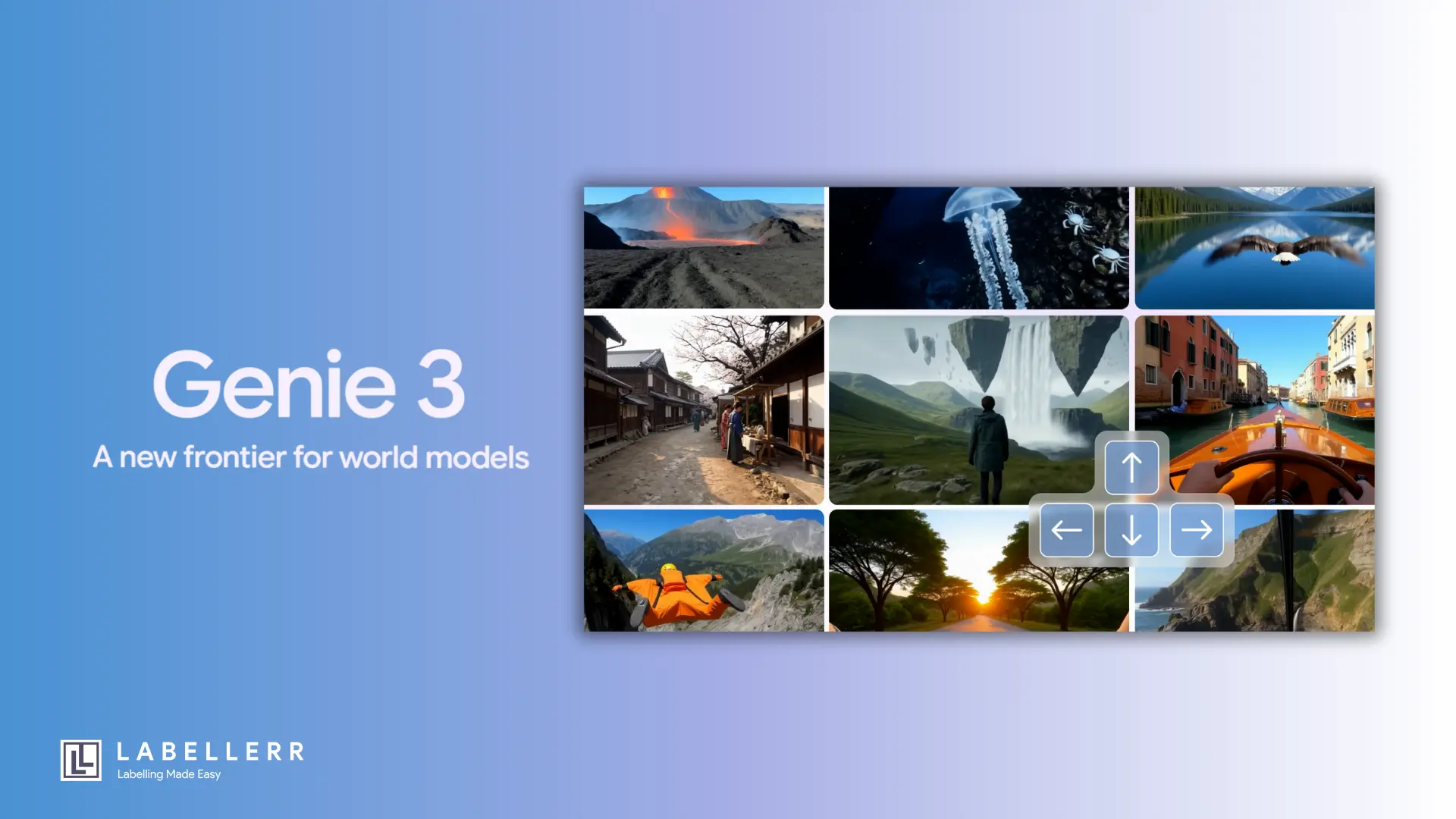How Genie 3 Builds Interactive 3D Scenes from Text
Genie 3, Google DeepMind’s latest AI world model, creates immersive 3D environments in real time from simple text prompts. It supports continuous interaction, dynamic world changes, and persistent memory—revolutionizing AI simulation and agent training.

Imagine typing a few words—"a medieval castle during a thunderstorm"—and not just seeing a picture, but stepping inside. You can walk through the stone corridors, hear the rain lash against the windows, and watch lightning illuminate the sky. This isn't a game that took years to build. This is a world that AI created for you in seconds.
On August 5, 2025, Google DeepMind unveiled Genie 3, a technology that does exactly that. For years, AI could generate images and then short videos.
But with Genie, AI learned to create living, breathing digital universes. This article will take you on a journey into how this technology works, show you what it can do, and explore how it's set to change our world.
How We Got Here?
The journey to Genie 3 started with simple steps. First, AI learned to create images from text. Then, it learned to stitch those images into short videos.
But these were passive experiences; you could only watch. DeepMind wanted to take the next leap: from watching a world to exploring it.
Their vision was to build a "physics engine of the imagination"—a tool that could bring any described reality to life.
This is the core idea behind a world model, an AI that doesn't just see the world but understands how it works. These models are a critical step toward creating more advanced and capable artificial intelligence.
How Does Genie 3 Works?

Genie 3 Architecture
So, how does Genie 3 turn words into worlds? It's not magic, but a combination of powerful technology and massive amounts of data.
At its heart, Genie 3 is an 11-billion-parameter auto-regressive transformer. Think of it like an author writing a story one word at a time. Genie builds its world one frame at a time, with each new frame intelligently based on all the previous ones. This ensures the world stays consistent as you move through it.
To make these worlds feel real, Genie uses several clever techniques:
- Multi-Scale Attention: It pays attention to both the fine details in front of you (local consistency) and the overall structure of the world (global coherence), so a building in the distance doesn't suddenly change as you get closer.
- Learned Physics: Genie wasn't taught physics equations. Instead, it learned how objects should behave by watching over 200,000 hours of videos, including gameplay and real-world footage. It figured out gravity, motion, and object interactions on its own. This is called emergent physics.
- Smart Memory: It has a multi-layered memory system to keep track of everything. Short-term memory handles immediate actions, while long-term memory ensures the world remains stable throughout your entire session.
- Real-Time Speed: Running on Google's powerful TPU v5 infrastructure, Genie can generate each new frame in just over 41 milliseconds, fast enough to deliver a smooth 24 frames per second (FPS) experience.
The true breakthrough is that Genie creates consistent worlds not because it was programmed to, but because it learned to. It even pre-generates multiple possible future frames, so it's ready no matter which direction you turn.
What Can You Do With Genie-3?
The best way to understand Genie 3 is to see the worlds it can create. Here are some real examples generated from simple text prompts.
- Natural Environments: Prompts like "A high-speed drone flight through a narrow canyon in Iceland with a river below" create stunning, explorable landscapes perfect for training autonomous agents.
- Urban & Architectural: You can build entire cities. A prompt like "A modern London canal street with graffiti-covered brick walls and narrowboats parked along the water" can be brought to life. You can even add dynamic events, such as "A massive, realistic dragon swoops low over the canal, its claws grazing the water".
- Fantasy & Creative: For pure imagination, a prompt like "Create an animated fantasy realm with interactive magical elements" will generate a world that feels straight out of a storybook. Simple physics tests like "A desert with a bouncing ball and a falling box" show the model understands how objects should interact.
- Educational & Training: Genie can create detailed learning environments. A prompt like "Inside a bustling bakery kitchen, with rows of freshly baked golden-brown loaves on cooling racks" creates an immersive and explorable space. It can even generate an "interactive solar system simulation with accurate planetary physics".
Why Does Genie-3 Stand Out?

Genie 3 Architecture
Genie 3 isn't just an incremental update; it's a leap forward. Its key features set it apart from anything that has come before.
Core Capabilities:
- High-Quality Rendering: It generates worlds in 720p resolution at a smooth 24 FPS.
- Extended Memory: The worlds it creates remain consistent and stable for several minutes of exploration.
- Dynamic Worlds: You can change the world on the fly with new prompts. For example, after creating a forest, you can prompt it to "start raining".
- Real-Time Interactivity: You can navigate these worlds using standard keyboard controls (WASD) with a response time of under 50 milliseconds.
- Persistent Memory: If you move an object and walk away, it will still be in its new location when you return.
Technical Specifications:
- Resolution: 720p HD
- Frame Rate: 24 FPS
- Duration: Several minutes of consistency
- Computing Power: Requires a minimum of 8 TPU v5 chips to run.
Evolution Upto Genie-3
Genie 3 didn't appear overnight. It is the result of years of research and development.
- Genie 1 could create static, unplayable environments.
- Genie 2 made a jump to interactivity, offering 10-20 seconds of playable scenes at 360p with very basic physics.
- Genie 3 represents a quantum leap. It extended the interaction time from seconds to several minutes, jumped from 360p to 720p quality, and evolved from simple physics to complex, learned interactions.
Use Cases
While gaming is an obvious use case, Genie 3's impact will be felt across many industries.
- AI and Robotics: Developers can train AI agents and robots in limitless, safe, and realistic virtual environments before deploying them in the real world.
- Game Development: Designers can instantly prototype levels and game mechanics, turning months of work into seconds of generation.
- Education: Students can take immersive field trips to ancient Rome, explore the solar system, or conduct virtual science experiments.
- Film and Animation: Directors can create and modify virtual sets in real-time, drastically speeding up the pre-visualization process.
Limitations Of Genie-3
Despite its incredible capabilities, Genie 3 is still an early technology and has limitations.
- Memory Duration: Worlds begin to lose consistency after several minutes.
- Action Space: The range of possible interactions within the world is still constrained.
- Complexity: It struggles to handle scenes with multiple independent characters or complex one-on-one combat scenarios.
- Computational Cost: Running Genie 3 is expensive. Early reports suggest access could cost over $1,000 per month, putting it out of reach for casual users for now.
Future Of World Generation Models
DeepMind is already working on the future. Their roadmap includes extending memory duration, expanding the range of possible actions, and reducing the computational cost. They also plan to integrate Genie 3 with other AI systems, like their SIMA agents, which could allow AI characters to navigate and interact within these generated worlds.
Conclusion
Genie 3 marks a pivotal moment in the history of artificial intelligence. It transforms AI from a passive generator of content into an active creator of experiences. It democratizes the ability to build virtual worlds, putting the power of creation into the hands of anyone with an idea.
This technology is more than just a tool; it's a new medium for creativity, education, and research. As we stand at the dawn of this new era, we have both an incredible opportunity and a profound responsibility to shape how these worlds will shape us. The future is not just something we will watch; it's something we can now build, one prompt at a time.
FAQs
What is Genie 3 by Google DeepMind?
Genie 3 is an advanced AI world model that generates interactive, explorable 3D environments from user prompts, supporting real-time dynamic events and continuous engagement.
How is Genie 3 different from previous models?
Unlike earlier AI models, Genie 3 can remember objects’ positions, render environments at 24 FPS in 720p, and allow real-time changes like weather or objects based solely on prompt updates.
What are the use cases for Genie 3?
Genie 3 can be used in AI agent training, game development, education, research, and simulation, offering flexible, controllable environments for experimentation.
Is Genie 3 available for public use?
Genie 3 is initially available to select researchers and creators as a limited preview; broader access is expected in the future.
What limitations does Genie 3 have?
Currently, Genie 3 does not simulate real-world locations exactly, supports limited interaction time, and is undergoing testing for multi-agent scenarios and large-scale deployments.

Simplify Your Data Annotation Workflow With Proven Strategies
.png)


